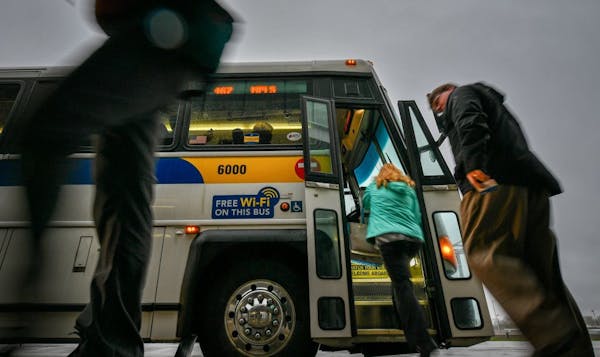Metro Transit officials facing a worsening driver shortage abruptly cut bus service Tuesday in a move to stabilize service across the Twin Cities — for now.
By canceling 67 trips across 40 routes for the foreseeable future — about 1 percent of the agency's daily operations — Metro Transit can staff the rest of its other runs and dramatically reduce the number of missed trips, said spokesman Howie Padilla. The agency has operated 99 percent of its runs, he said, but fallen short of its goal of 100 percent.
"These are not adjustments we want to make," Padilla said. "Rather than put it off, we came out with it at once. We want to honor our commitment of reliability, and we were not doing that. We need bodies to do that."
Metro Transit, the state's largest public transit agency, has been struggling with a driver shortage for months as it operates 130 routes and provides 260,000 trips a day. It has 90 open driver positions, and like transit agencies nationwide, can't find people to fill them.
Without enough drivers, the agency had been canceling trips on a day-by-day basis, a scenario Padilla said was "no longer sustainable." Plus, the agency heard from riders who disliked the last-minute cancellations announced via e-mail and social media, sometimes when people were already at their bus stops.
Jennifer Olson, who commutes by bus from her northwest suburban home to Minneapolis, said she had noticed the decline in reliable service recently.
She would be waiting for the bus, only to receive a last-minute alert from Metro Transit saying the trip was canceled. On Tuesday, she was pleased Metro Transit had taken more definitive action.
"When trips are canceled, you get disgusted," Olson said. "If you cut buses and make it a permanent change, riders know what to expect. I hope this will help."
Metro Transit said no additional cuts to regular service are planned, but the shortage will affect service for the State Fair.
Driver shortage
Efforts by Metro Transit to attract more drivers have been stymied by a strong economy and a low unemployment rate — a conundrum facing transit agencies nationwide. Metro Transit's vacancies have increased; in May the agency had 57 openings.
Starting pay for bus drivers at Metro Transit is about $20 an hour. Padilla said the agency is exploring ways to make the job more appealing, such as offering shifts that include weekends or holidays only or hiring more part-time drivers to fill vacant slots.
"This is not a problem unique to us," Padilla said. "There are shortages of drivers with commercial driver's licenses."
Metro Transit has hired 25 additional drivers in recent weeks, Padilla said, but they are in training and it will be awhile before they hit the streets.
"It's a serious crisis," said Ryan Timlin, president of the Amalgamated Transit Union Local 1005, which represents about 2,400 drivers, mechanics, LRT operators and others at Metro Transit.
Timlin said part of the issue is that a large number of Metro Transit drivers are retiring, and younger people aren't interested in applying for the work.
"You're told that you have to go to college, even though you can make a really good living driving a bus or in the [building] trades," he said.
In addition, high-profile assaults of bus drivers, many of which have been widely disseminated on social media, may deter possible applicants, Timlin said.
While Metro Transit has been paying some drivers overtime, Timlin said, "the workforce has been severely overburdened and has been for some time, and now it's starting to show."
Suburban bus operators haven't appeared to cancel trips due to driver shortages, although attracting drivers remains a concern.
"All transit agencies across the country face some challenges," said Luther Wynder, executive director of the Minnesota Valley Transit Authority, which serves communities in Dakota and Scott counties with about 200 operators.
"Some [agencies] are in a better position in terms of workforce," he said. "We have operators who want to serve suburban communities and we have been fortunate to attract and keep some really good [drivers]."
Interrupted service
Metro Transit bus ridership is down 4.6 percent this year, compared with last year. But buses continue to be the workhorses of Metro Transit, providing 27.4 million rides in the first half of 2018.
The trips Metro Transit cut were chosen for a number of reasons, Padilla said.
They included runs with low ridership and routes on which riders could shift to earlier or later trips or where riders could choose other options.
Some routes will have multiple suspensions. Route 3, which runs between downtown Minneapolis and downtown St. Paul, will have six fewer trips a day. Route 270, an express bus from Minneapolis to Mahtomedi, will have four fewer trips. Route 18, which runs from downtown Minneapolis to Bloomington, will have three fewer morning trips.
Come time for the State Fair, Metro Transit is planning less service to that event than it has in past years. Weekday express service from metro area park-and-ride lots won't start until 9 a.m. on weekdays. In the past, it has started at 8 a.m.
The cuts announced Monday are already reflected on Metro Transit's online schedules and NexTrip service. Regular quarterly scheduled service changes go into effect Aug. 18.
Mary Morse Marti, executive director of the city's transportation management organization Move Minneapolis, urged commuters to stick with Metro Transit and ask for help if needed.
"We are sorry service is being interrupted," she said, "but we stand ready to help people get to work downtown."
8 months in jail for Blaine man who caused 120-mph crash hours after he was caught speeding

Daughter sues St. Paul, two officers in Yia Xiong's killing

